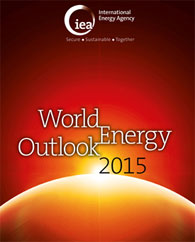In advance of this month’s UN Climate Summit in Paris, the International Energy Agency (IEA) released its annual report, World Energy Outlook 2015 – that will help leaders bolster the argument for a quick transition to renewable energy.
While IEA "sees clear signs that the energy transition is underway," it "warns strong direction is needed from the Paris Climate Summit." The report presents projections to 2040 for how the world’s energy system will evolve.
"The next 25 years will see a radical shift towards renewables and away from coal, a global energy center of gravity pivoting towards India and the prospect of Africa leapfrogging dirty energy."

The main points are:
- Renewable energy will replace coal as the world’s largest source of electricity around 2030, led by solar energy. By 2040, over 1,000 gigawatts (GW) of solar will be installed worldwide.
By 2040, renewables will supply 50% of electricity in the EU, 30% in China and Japan, and above 25% in the US and India.
-
Last year, almost half of new generating capacity was renewable energy worldwide, and mandatory energy efficiency policies apply to more than 25% of global consumption.
- Subsidies still favor fossil fuels over renewable energy, however, at $490 billion and $112 billion respectively in 2014.
With sharply lower oil prices, however, countries like India and Indonesia have started to phase out fossil subsidies.
-
China will hand the baton for out-sized energy demand to India. Worldwide, energy demand will grow by nearly a third, driven by developing countries, and Africa could be the first to leapfrog fossil fuels to power economic development with renewable energy.
- The connection between economic growth and emissions will continue to weaken as all countries become more energy efficient, and as China transforms to a more service-oriented economy.
"A prolonged period of lower oil prices could undercut this crucial pillar of the energy transition; diminished incentives and longer payback periods mean that 15% of the energy savings are lost in a low oil price scenario. Lower prices alone would not have a large impact on the deployment of renewables, but only if policymakers remain steadfast in providing the necessary market rules, policies and subsidies," notes IEA.
Because the current emissions trajectory leads to temperature rise of 2.7°C, "A major course correction is still required to achieve the world’s agreed climate goal."
Underestimating the Future?
While this is true, keep in mind that IEA has historically underestimated the growth of renewable energy. From 2000-2007, for example, IEA projected 20 GW of solar would be installed worldwide – yet, as of 2014, there’s almost 180 GW. IEA couldn’t have known how much solar costs would decline, and now they can’t predict the fast transition that’s possible if we finally get the will.
According to the World Resources Institute, renewable energy will collectively more than double by 2030 in 8 of 10 of the world’s biggest emitters: US, EU, Japan, Mexico, Brazil, China, Indonesia and India – because of their national climate pledges.
Read IEA’s Executive Summary:

I heard Adam Sieminski, the EIA’s administrator, give a briefing at Columbia U. this morning, and I believe he said that renewables would supply only 14% of world energy supply by 2040. Any explanation of the discrepancy here?